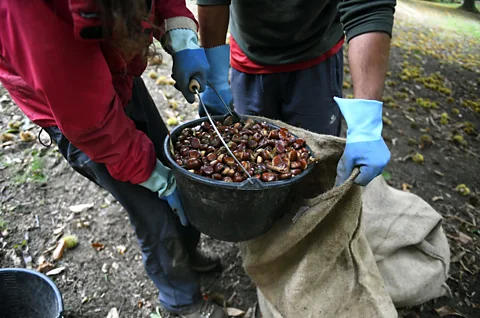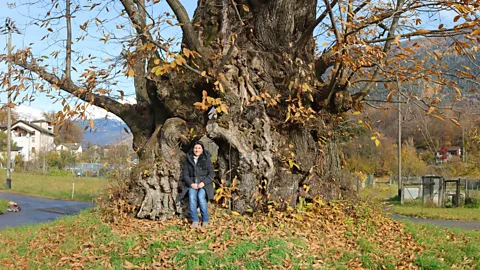The ancient Romans left an indelible imprint on the world they enveloped into their empire. The straight, long-distance roads they built can still be followed beneath the asphalt of some modern highways. They spread aqueducts, sewers, public baths and the Latin language across much of Europe, North Africa and the Middle East. But what’s perhaps less well known is the surprising way they transformed Europe’s forests.
According to researchers in Switzerland, the Romans had something of a penchant for sweet chestnut trees, spreading them across Europe. But it wasn’t so much the delicate, earthy chestnuts they craved – instead, it was the fast-regrowing timber they prized most, as raw material for their empire’s expansion. And this led to them exporting tree cultivation techniques such as coppicing too, which have helped the chestnut flourish across the continent.
“The Romans’ imprint on Europe was making it into a connected, economical space,” says Patrik Krebs, a geographer at the Swiss Federal Institute for Forest, Snow and Landscape Research (WSL). “They built a single system of governance all over Europe, they improved the road system, the trade system, the military system, the connection between all the different people all over Europe.”
As a result of that connection, “specific skills in arboriculture [the cultivation of trees] were shared by all the different civilisations”, he says.
The arboreal legacy of the Romans can still be found today in many parts of Europe – more than 2.5 million hectares (6 million acres) of land are covered by sweet chestnut trees, an area equivalent in size to the island of Sardinia. The trees have become an important part of the landscape in many parts of the continent and remain part of the traditional cuisine of many countries including France and Portugal.
 Getty Images
Getty ImagesKrebs works at a branch of the WSL in Switzerland’s Ticino canton on the southern slope of the Alps, an area that is home to giant chestnut trees, where many specimens have girths greater than seven metres (23ft). By the time of the Middle Ages, sweet chestnuts were a staple food in the area. But it was the Romans who brought the trees there – before their arrival in Ticino, sweet chestnuts did not exist there, having been locally wiped out in the last ice age, which ended more than 10,000 years ago.
Using a wide range of evidence, including paleoecological pollen records and ancient Roman texts, Krebs’ research team analysed the distribution of both sweet chestnut (Castanea sativa) and walnut (Juglans regia) trees in Europe before, during and after the Roman empire. Sweet chestnut and walnut trees are considered useful indicators of the human impact on a landscape, as they generally benefit from human management – such as pruning and supressing competing trees. Their fruits and timber are also highly desirable.
In countries such as Switzerland, France and parts of Germany, sweet chestnut pollen was near-absent from the wider pollen record – such as, for example, fossil pollen found in sediment and soil samples – before the Romans arrived, according to the study and previous research. But as the Roman Empire expanded, the presence of sweet chestnut pollen grew. Specifically, the percentage of sweet chestnut pollen relative to other pollen across Europe “shows a pattern of a sudden increase around year zero [0AD], when the power of the Roman empire was at its maximum” in Europe, Krebs says.
 Swiss Federal Institute for Forest, Snow and Landscape
Swiss Federal Institute for Forest, Snow and LandscapeAfter the Barbarian sacks of Rome around 400-500 AD, which signalled the beginning of the end of the Roman Empire amid widespread upheaval, the chestnut pollen percentage then drops temporarily. This decrease suggests that many of the Roman-era orchards were abandoned, Krebs says, probably not only due to the fall of the Roman Empire, but also, because a wider population decline in many areas at the time.